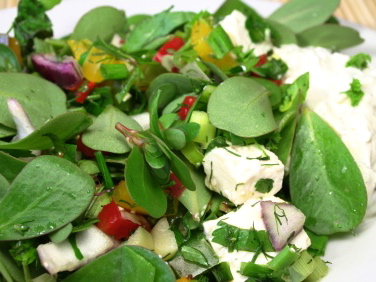
reference-image, l
(article, Susan Allport)
[%pageBreakSettings nobreak=true][%adInjectionSettings noInject=true] h3. From Chapter 10: Where Have All The Omega-3s Gone? Perhaps the most interesting perspective on how diets have been changing comes from a research tack taken by Artemis Simopoulos after the 1985 conference \[chaired by Simopoulos on the role of fatty acids in the human diet\]. The food tables that were available at the time of the conference listed the content of very few green vegetables. But those figures — for spinach, leeks, lettuce, kale, and broccoli — were surprising to Simopoulos. [[block(sidebar). h1. About the book and author The Queen of Fats is a brief survey of the history of our knowledge of essential fatty acids, of which the omegas (omega-3 and omega-6) are the most familiar. In a nutshell (preferably walnut, which is high in omega-3s), consumers of the modern Western diet eat too many omega-6s and not enough omega-3s, with grave consequences for our overall health. Eating fish helps boost our omega-3s, but as Susan Allport — a journalist whose previous food/science work includes the book [%bookLink code=0609601490 "The Primal Feast"] — explains in this excerpt, getting your greens is important too. Excerpt reprinted with permission of the University of California Press (2006). ]] These green leafy vegetables, it appeared, have significant amounts of fat. Not as much fat as seeds, grains, or the flesh of fish and fowl, certainly, but more fat than most people would have ever expected. And what fats they do have are mostly alpha linolenic acid, from the omega-3 family. "All grains are high in omega-6s, and all green plants are high in omega-3s," says Simopoulos today. This same realization led her in 1985 to hypothesize that a diet rich in greens might also be a significant source of the omega-3 fats. Simopoulos, who was born in Greece but attended college and medical school in the United States, remembered how the animals ate in her native country. She recalled how goats scrambled up the hills to browse on bushes and how chickens scratched for insects and wild greens, and she wondered if those wild greens make a difference in the eggs, milk, cheese, and meat that is eaten in Greece, a country with very little heart disease. The Greeks are also a fish-eating population with a high intake of olive oil, two aspects of the diet that are usually given all the credit for the low rate of heart disease, but Simopoulos became curious about the role of greens. Simopoulos began by testing purslane, one of the most common wild greens in Greece (and many other countries). She was amazed to find that this ordinary plant, a weed in most of the world's eyes, has an alpha linolenic acid content four times that of cultivated spinach (about 0.4 grams per 100 grams). Purslane is not a cold-adapted plant like some other greens full of omega-3s, such as rapeseed (canola), spinach, and aquatic plants. It is not for that reason that it is full of omega-3s. Rather, botanists suspect, its high level of omega-3s works to compensate for light damage, since purslane grows in intense sunlight. (Linseed, or flaxseed, is another plant that is high in alpha linolenic acid and grows in a hot climate.) [%image feature-image float=left width=400 caption="Eat a purslane salad and get your omega-3s."] Then Simopoulos tested a Greek egg, which came from a Greek chicken that had feasted on purslane, insects, and only small amounts of corn. She found that this egg was extremely rich (1.78 grams per 100 grams) in all the omega-3 fatty acids, including DHA and eicosapentaenoic acid — as rich as, if not richer than, many species of fish. (One hundred grams of farmed Atlantic salmon have about the same amount of omega-3 fatty acids. Sardines have more, and anchovies have less.) An egg purchased in an American supermarket, in contrast, had a tenth the omega-3 fatty acids as its Greek counterpart. The American egg had come from a factory-raised chicken, fed largely on corn. In time, other researchers would find the same pattern in free-range versus grain-fed beef, lamb, and pork (and in the milk and cheese from these animals), and botanists would clarify the role played by alpha linolenic and linoleic acids in plants, the source of both these essential fats. Alpha linolenic acid is the fat that plants use in the membranes of their chloroplasts (the thylacoid membrane), the fat that surrounds their complex machinery of photosynthesis and enables plants to capture photons and turn them into carbohydrates. Linoleic acid, in contrast, is a kind of storage fat for plants, to be turned into alpha linolenic acid as needed by a special desaturase enzyme that only plants have. It is found in highest concentrations in seeds and has no other function in plants than to be the precursor of alpha linolenic acid. It is less prone to oxidation than its omega-3 cousin, as we know, and thus can be safely stored until photosynthesis is necessary at the moment of germination. And so it seemed to Simopoulos that one of the most important ways that the diets of Western countries have been changing is that Western populations are consuming more seeds, and the fats of seeds, and fewer greens, and the fats of greens.

reference-image, l

feature-image, l

featurette-image, l

promo-image, l

newsletter-image, l